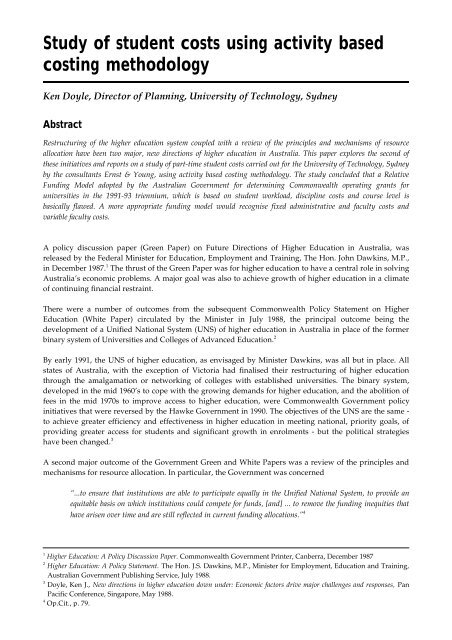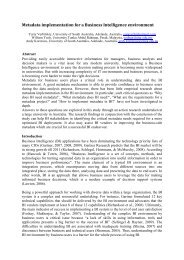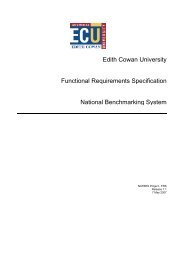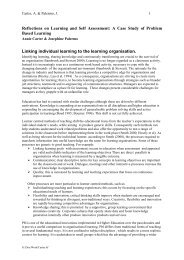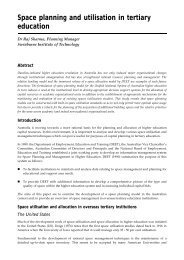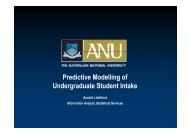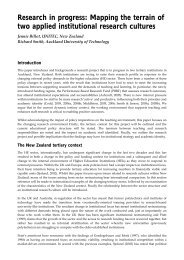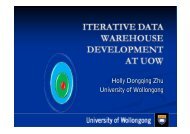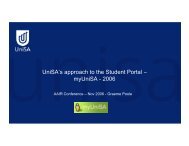Study of student costs using activity based costing methodology - aair
Study of student costs using activity based costing methodology - aair
Study of student costs using activity based costing methodology - aair
Create successful ePaper yourself
Turn your PDF publications into a flip-book with our unique Google optimized e-Paper software.
<strong>Study</strong> <strong>of</strong> <strong>student</strong> <strong>costs</strong> <strong>using</strong> <strong>activity</strong> <strong>based</strong><br />
<strong>costing</strong> <strong>methodology</strong><br />
Ken Doyle, Director <strong>of</strong> Planning, University <strong>of</strong> Technology, Sydney<br />
Abstract<br />
Restructuring <strong>of</strong> the higher education system coupled with a review <strong>of</strong> the principles and mechanisms <strong>of</strong> resource<br />
allocation have been two major, new directions <strong>of</strong> higher education in Australia. This paper explores the second <strong>of</strong><br />
these initiatives and reports on a study <strong>of</strong> part-time <strong>student</strong> <strong>costs</strong> carried out for the University <strong>of</strong> Technology, Sydney<br />
by the consultants Ernst & Young, <strong>using</strong> <strong>activity</strong> <strong>based</strong> <strong>costing</strong> <strong>methodology</strong>. The study concluded that a Relative<br />
Funding Model adopted by the Australian Government for determining Commonwealth operating grants for<br />
universities in the 1991-93 triennium, which is <strong>based</strong> on <strong>student</strong> workload, discipline <strong>costs</strong> and course level is<br />
basically flawed. A more appropriate funding model would recognise fixed administrative and faculty <strong>costs</strong> and<br />
variable faculty <strong>costs</strong>.<br />
A policy discussion paper (Green Paper) on Future Directions <strong>of</strong> Higher Education in Australia, was<br />
released by the Federal Minister for Education, Employment and Training, The Hon. John Dawkins, M.P.,<br />
in December 1987. 1 The thrust <strong>of</strong> the Green Paper was for higher education to have a central role in solving<br />
Australia’s economic problems. A major goal was also to achieve growth <strong>of</strong> higher education in a climate<br />
<strong>of</strong> continuing financial restraint.<br />
There were a number <strong>of</strong> outcomes from the subsequent Commonwealth Policy Statement on Higher<br />
Education (White Paper) circulated by the Minister in July 1988, the principal outcome being the<br />
development <strong>of</strong> a Unified National System (UNS) <strong>of</strong> higher education in Australia in place <strong>of</strong> the former<br />
binary system <strong>of</strong> Universities and Colleges <strong>of</strong> Advanced Education. 2<br />
By early 1991, the UNS <strong>of</strong> higher education, as envisaged by Minister Dawkins, was all but in place. All<br />
states <strong>of</strong> Australia, with the exception <strong>of</strong> Victoria had finalised their restructuring <strong>of</strong> higher education<br />
through the amalgamation or networking <strong>of</strong> colleges with established universities. The binary system,<br />
developed in the mid 1960’s to cope with the growing demands for higher education, and the abolition <strong>of</strong><br />
fees in the mid 1970s to improve access to higher education, were Commonwealth Government policy<br />
initiatives that were reversed by the Hawke Government in 1990. The objectives <strong>of</strong> the UNS are the same -<br />
to achieve greater efficiency and effectiveness in higher education in meeting national, priority goals, <strong>of</strong><br />
providing greater access for <strong>student</strong>s and significant growth in enrolments - but the political strategies<br />
have been changed. 3<br />
A second major outcome <strong>of</strong> the Government Green and White Papers was a review <strong>of</strong> the principles and<br />
mechanisms for resource allocation. In particular, the Government was concerned<br />
“...to ensure that institutions are able to participate equally in the Unified National System, to provide an<br />
equitable basis on which institutions could compete for funds, [and] ... to remove the funding inequities that<br />
have arisen over time and are still reflected in current funding allocations.” 4<br />
1 Higher Education: A Policy Discussion Paper. Commonwealth Government Printer, Canberra, December 1987<br />
2 Higher Education: A Policy Statement. The Hon. J.S. Dawkins, M.P., Minister for Employment, Education and Training,<br />
Australian Government Publishing Service, July 1988.<br />
3 Doyle, Ken J., New directions in higher education down under: Economic factors drive major challenges and responses, Pan<br />
Pacific Conference, Singapore, May 1988.<br />
4 Op.Cit., p. 79.
Whereas Commonwealth funding, which currently represents in excess <strong>of</strong> 80% <strong>of</strong> most institution income,<br />
was previously on an annual basis, a rolling triennial process was introduced from 1989 for the 1990/92<br />
triennium to enable institutions to plan for future growth. Institutions were required to negotiate annually<br />
with the Commonwealth their growth proposals and educational pr<strong>of</strong>ile for the following triennium.<br />
Another major resource initiative was the introduction from 1991 <strong>of</strong> a Relative Funding Model (RFM) for<br />
higher education. This was aimed at meeting the Government’s commitment in the Green and White<br />
Papers to fund institutions <strong>of</strong> higher education on the basis <strong>of</strong> what they do rather than historical<br />
precedent and arbitrary classification. The Government recognised<br />
that significant distortions existed in the base allocation <strong>of</strong> Commonwealth higher education operating grants<br />
and undertook to develop an approach which would provide a more equitable distribution <strong>of</strong> base funding. 5<br />
Following the commissioning <strong>of</strong> three studies <strong>of</strong> relative teaching <strong>costs</strong> and consultation with universities<br />
on the principles and framework for the model, the Commonwealth Department <strong>of</strong> Education,<br />
Employment and Training (DEET) developed the RFM <strong>based</strong> on a two dimensional matrix, <strong>using</strong><br />
discipline cost as one axis and course level as the other. A limited number <strong>of</strong> teaching cost categories (or<br />
clusters) were selected in order to keep the model simple (5 clusters were selected at undergraduate and 2<br />
at postgraduate level) and 3 course levels were adopted -undergraduate, other postgraduate, and research<br />
degree. The relative weightings <strong>of</strong> each cell in the matrix were established from the findings <strong>of</strong> the three<br />
teaching cost studies. Details <strong>of</strong> the model are shown below.<br />
Relative Funding Model: Clustering <strong>of</strong> disciplines 6<br />
Cluster<br />
1<br />
2<br />
3<br />
Undergraduate<br />
Accounting<br />
Administration, Economics<br />
Law<br />
Other Humanities<br />
Behavioural Science<br />
Education<br />
Mathematics, Statistics<br />
Other Social Studies<br />
Computing<br />
Nursing<br />
Other Built Environment<br />
Other Health<br />
Other Languages<br />
Visual & Performing Arts<br />
Other Postgraduate<br />
Accounting<br />
Administration, Economics<br />
Law<br />
Other Humanities<br />
Education<br />
Mathematics, Statistics<br />
Other Social Studies<br />
Computing<br />
Nursing<br />
Other Built Environment<br />
Other Health<br />
Other Languages<br />
Visual & Performing Arts<br />
Research Degree<br />
Accounting<br />
Administration, Economics<br />
Computing<br />
Education<br />
Law<br />
Mathematics, Statistics<br />
Nursing<br />
Other Built Environment<br />
Other Health<br />
Other Humanities<br />
Other Languages<br />
Other Social Studies<br />
Visual & Performing Arts<br />
4<br />
5<br />
Engineering<br />
Science<br />
Surveying<br />
Agriculture<br />
Dentistry<br />
Medicine<br />
Veterinary Science<br />
Agriculture<br />
Behavioural Science<br />
Dentistry<br />
Engineering<br />
Medicine<br />
Science<br />
Surveying<br />
Veterinary Science<br />
Agriculture<br />
Behavioural Science<br />
Dentistry<br />
Engineering<br />
Medicine<br />
Science<br />
Surveying<br />
Veterinary Science<br />
5 Assessment <strong>of</strong> the relative funding position <strong>of</strong> Australia’s higher education institutions, The Hon. Peter Baldwin, M.P.,<br />
Minister for Higher Education & Employment Services, August 1990, p. 1.<br />
6 Ibid., p. 13.
Relative Funding Model: Relative teaching <strong>costs</strong> matrix 7<br />
Cluster<br />
1<br />
1.0<br />
1.4<br />
2 1.3<br />
2.0<br />
3<br />
4<br />
5<br />
Undergraduate<br />
1.6<br />
2.2<br />
2.7<br />
Discipline Weights<br />
Other Postgraduate<br />
1.8<br />
3.0<br />
Research Degree<br />
4.7<br />
Operating grants for the 1991-93 triennium were calculated by summing the institution’s teaching load<br />
(which, in Australia, is expressed in Equivalent Full-Time Student Units - EFTSUs) in each cell <strong>of</strong> the<br />
matrix after multiplying the load in each cell by the relative weighting factor. DEET has advised<br />
institutions that the formula would be used on a once only basis, for determining 1991-93 operating grants<br />
and thereafter would determine grants on an historical basis.<br />
With the exception <strong>of</strong> special funding for <strong>student</strong>s on industrial experience, given a weighting <strong>of</strong> 0.2<br />
EFTSU, the model does not attempt to cover institution-specific cost factors, such as, remoteness <strong>of</strong><br />
campus, smallness <strong>of</strong> scale, etc. Furthermore, the RFM provides for a discretionary element to be allocated<br />
to institutions on an annual basis. In publishing the RFM the Government noted that the weightings were<br />
consistent with the bands established for funding purposes by the UK Department <strong>of</strong> Education and<br />
Science and the New Zealand Ministry <strong>of</strong> Education. 8<br />
During the development <strong>of</strong> the model there were several steps taken to consult with institutions and to<br />
seek feedback on critical attributes <strong>of</strong> the model. In November 1989, at an early stage in the development<br />
<strong>of</strong> the model, there were many suggestions presented at a seminar held in Canberra, including comments<br />
that the development <strong>of</strong> the model should be open and objective, the model should be simple, and should<br />
contain real <strong>costs</strong> rather than ideal inputs. In relation to this latter comment it was stated:<br />
The model should relate directly to current patterns <strong>of</strong> institutional expenditure rather than <strong>costs</strong> <strong>based</strong> on<br />
ideal inputs, and differentiate reliably between institutions with different educational pr<strong>of</strong>iles. 9<br />
In this context, some Vice-Chancellors argued that the <strong>costs</strong> <strong>of</strong> administering part-time <strong>student</strong>s and the<br />
industrial component <strong>of</strong> co-operative education or sandwich courses should be fully recognised.<br />
Subsequently, a special loading was acknowledged for administering the industrial component <strong>of</strong><br />
co-operative education courses but hard data was sought on the cost <strong>of</strong> administering part-time <strong>student</strong>s.<br />
This paper reports on a study undertaken for the University <strong>of</strong> Technology, Sydney (UTS) by the<br />
consultants, Ernst and Young on the cost <strong>of</strong> pan-time study. UTS is the largest national provider <strong>of</strong><br />
part-time education, with almost 9,000 <strong>student</strong>s enrolled under this mode in 1990 (46% <strong>of</strong> total<br />
enrolments), although all thirty-six public institutions <strong>of</strong> higher education in Australia reported a<br />
proportion <strong>of</strong> their total <strong>student</strong>s enrolled in pan-time study in 1990. The study focused on pan-time,<br />
internal <strong>student</strong>s not external or continuing education <strong>student</strong>s.<br />
Whereas pan-time <strong>student</strong>s were for many years counted by the Commonwealth Government as<br />
equivalent to half a full-time <strong>student</strong> and this served also as the basis for funding institutions, in 1982 the<br />
Government adopted EFTSU as a <strong>student</strong> load measure and counted part-time <strong>student</strong>s as <strong>student</strong>s<br />
undertaking 0.75 or less <strong>of</strong> a full-time <strong>student</strong> load. As the principal basis for determining institutional<br />
operating grants has been reported <strong>student</strong> load, the claim <strong>of</strong> institutions committed to pan-time<br />
education has been that, for most if not all, administrative and support activities, a pan-time <strong>student</strong><br />
incurs at least the same administrative load and cost as a full-time <strong>student</strong>, not one-half or three-quarters<br />
<strong>of</strong> the load and cost.<br />
7 Ibid., p. 13.<br />
8 Ibid., p. 21.<br />
9 Relative Funding Model: A Draft Proposal. Department <strong>of</strong> Employment, Education and Training, National Board <strong>of</strong><br />
Employment, Education and Training, June 1990, p. 6.
Setting aside the educational and social merits <strong>of</strong> part-time study, there have been few attempts to<br />
determine the relative institutional <strong>costs</strong> <strong>of</strong> this alternative mode <strong>of</strong> study, either in Australia or overseas.<br />
Also the findings have been equivocal and some studies have looked beyond institutional <strong>costs</strong> to the<br />
human and social <strong>costs</strong> <strong>of</strong> part-time study and the need for financial support for pan-time <strong>student</strong>s. 10<br />
The <strong>methodology</strong> adopted for these previous studies has focused on determining marginal <strong>costs</strong> where<br />
estimations and the attribution <strong>of</strong> overheads represent significant complexities. But, apart from these<br />
difficulties, there is evidence to suggest that part-time <strong>student</strong>s are not accorded the same attention or<br />
service by some institutions as full time <strong>student</strong>s, and financial constraints on institutions limit the extent<br />
to which pan-time <strong>student</strong>s can be served. 11 Thus it is not surprising that some studies have suggested that<br />
the institutional cost <strong>of</strong> part-time is lower than full-time education. 12<br />
While research in the 1970’s provided clear evidence <strong>of</strong> increasing numbers <strong>of</strong> adults who are continuing<br />
their education on a part-time basis, one <strong>of</strong> the impacts <strong>of</strong> global recession since the late 1980s has been to<br />
improve retention rates both at high school and at University, particularly <strong>of</strong> full-time <strong>student</strong>s. 13<br />
However, it seems that part-time <strong>student</strong>s in present times are more likely to be concerned to retain their<br />
employment at the expense <strong>of</strong> continuing pan-time classes.<br />
So, the pan-time <strong>student</strong> may not only suffer some social and opportunity cost <strong>of</strong> foregone leisure time but<br />
appears to be discriminated against by some institutions in terms <strong>of</strong> services, and may be pressured by<br />
employers in times <strong>of</strong> economic difficulty. If, on top <strong>of</strong> these factors, the cost <strong>of</strong> providing services and<br />
support to part-time <strong>student</strong>s is only partially funded, and retention <strong>of</strong> full-time <strong>student</strong>s remains high,<br />
there are significant reasons for discontinuing this alternative mode <strong>of</strong> study. For an institution like UTS,<br />
committed to supporting part-time <strong>student</strong>s, the motivation to have an independent study <strong>of</strong> pan-time<br />
<strong>student</strong> <strong>costs</strong>, <strong>using</strong> a recognised <strong>costing</strong> <strong>methodology</strong> was high.<br />
In October 1990, UTS invited expressions <strong>of</strong> interest and tenders for the conduct <strong>of</strong> a study <strong>of</strong> part-time<br />
<strong>student</strong> <strong>costs</strong>. Three major accounting firms were approached and each submitted proposals <strong>based</strong> on the<br />
modern, <strong>activity</strong> <strong>based</strong> <strong>costing</strong> (ABC) <strong>methodology</strong> developed by Kaplan at Harvard University. 14<br />
Each had previous experience in its application and the tendered price for the study varied marginally<br />
between all three firms. The preferred proposal from Ernst and Young was favoured for their proposal to<br />
establish a residual framework to enable UTS to continuously monitor the cost effectiveness <strong>of</strong> its teaching<br />
and support activities. As part <strong>of</strong> the preliminary briefing <strong>of</strong> the three firms, the UTS organisation<br />
structure, details <strong>of</strong> the university budget for 1990, as well as an annual report were provided to each firm.<br />
In addition, the following life cycle <strong>of</strong> activities associated with the process <strong>of</strong> a <strong>student</strong> through the<br />
university was provided. 15<br />
10 Venables, Ethel. The Human Costs <strong>of</strong> Part-time Day Release, Journal <strong>of</strong> Higher Education, 1, 3, August 1972, pp. 267-85.<br />
Walker, Allan W. Pr<strong>of</strong>ile <strong>of</strong> Part-time Credit Students, Saskatchewan Journal <strong>of</strong> Educational Research and Development, 6,<br />
2, Spring 1976, pp. 18-24.<br />
Horch, Dwight H. Simulation <strong>of</strong> Financial Needs and Contributions <strong>of</strong> Adult Part-time Students, Research Report,<br />
Educational Testing Service, Princeton, N.J., June 1976.<br />
Gleeson, A.J. An Analysis <strong>of</strong> the Costs <strong>of</strong> Part-time and Full-time <strong>Study</strong> at Colleges <strong>of</strong> Advanced Education, Doctoral Thesis,<br />
La Trobe University, 1979.<br />
11 Kegal, Paul L. Community and Junior College Concern for Services Provided to Part-time Students, Research Report,<br />
March 1977.<br />
Mangham, Clarence. Part-time Students. Conference Paper presented to the Board <strong>of</strong> Governors <strong>of</strong> the California<br />
Community Colleges, Sacramento, June 1975.<br />
12 Brinkman, Paul T. The Financial Impact <strong>of</strong> Part-time Enrolments on Two Year Colleges: A Marginal Cost Perspective.<br />
National Center for Higher Education Management Systems, April 1983.<br />
13 National Advisory Council on Extension and Continuing Education, Washington, D.C. Annual Report: Equity <strong>of</strong> Access:<br />
Continuing Education and Part-time Students, March 1975.<br />
14 Kaplan, Robert S., Johnson, Thomas H. Relevance Lost: The Rise and Fall <strong>of</strong> Management Accounting. Harvard Business<br />
Press, 1987.<br />
15 Doyle, Ken J. Life Cycle <strong>of</strong> Institutional Activities Contributing to Student Cost, University <strong>of</strong> Technology, Sydney,<br />
November 1990.
Life Cycle <strong>of</strong> Institutional Activities Contributing to Student Costs<br />
As Ernst & Young explained, ABC was chosen as the most appropriate approach to the study for the<br />
following reasons:<br />
1. Activity Based Costing concentrates on the identification and allocation <strong>of</strong> <strong>costs</strong> to the activities undertaken by an<br />
organisation. This technique allows greater management insight into the reasons for cost behaviour, as compared<br />
to the more traditional classification <strong>of</strong> <strong>costs</strong> by departments and cost centres. Many activities cut across<br />
functional departmental boundaries and are thus hidden in many traditional accounting classification systems.<br />
Activity Based Costing has been developed so as to eliminate the necessity for the arbitrary nature <strong>of</strong> cost<br />
allocation and apportionment that is a prevalent feature <strong>of</strong> many orthodox. cost accounting systems.<br />
2. Activity Based Costing seeks to determine the event that gives rise to the <strong>activity</strong> and hence cost to be incurred.<br />
This event under the Activity Based Costing <strong>methodology</strong> is called the Cost , Driver. Cost drivers therefore<br />
become the link between activities and the consumption <strong>of</strong> resources by the final product or service. Cost drivers<br />
allow management to understand , why activities take place and resultant <strong>costs</strong> are incurred, which facilitates the<br />
process <strong>of</strong> cost control and planning.<br />
3. Activity Based Costing depends on the establishment <strong>of</strong> a bill <strong>of</strong> <strong>activity</strong> for the product or service produced. This<br />
bill <strong>of</strong> <strong>activity</strong> can only be completed once the processes, sub-processes and activities undertaken within an<br />
organisation are understood and documented. The cost per unit <strong>of</strong> the driver that has been determined for each<br />
<strong>activity</strong> is used as the link between costed <strong>activity</strong> pools and unit service or product <strong>costs</strong>.<br />
4. Activity Based Costing provides management with a new approach to the issues <strong>of</strong> cost planning and control.<br />
Rather than managing the dollar expenditures that result from management policy and actions or operational<br />
procedures and transactions, Activity Based Costing allows management to manage the driver. This approach
enables management to effect long term changes to cost behaviours and is a vital tool in the establishment <strong>of</strong><br />
operational budgets <strong>using</strong> a bottom-up approach. 16<br />
The approach adopted by Ernst and Young was <strong>based</strong> on the following ABC model. 17<br />
The assignment <strong>methodology</strong> involved six stages:<br />
1. Interview program to determine activities<br />
2. Accounts analysis and creation <strong>of</strong> cost pools<br />
3. Establishment <strong>of</strong> cost drivers<br />
4. Survey <strong>of</strong> faculty <strong>costs</strong><br />
5. Development <strong>of</strong> ABC model<br />
6. Analysis <strong>of</strong> <strong>student</strong> <strong>costs</strong><br />
1. Interview Program<br />
The initial phase in the study involved a program <strong>of</strong> interviews with administrative and support<br />
department managers and deans <strong>of</strong> all faculties to obtain a detailed knowledge <strong>of</strong> the activities <strong>of</strong> each<br />
department and faculty and an understanding <strong>of</strong> what drives the cost <strong>of</strong> each <strong>activity</strong>. The life cycle <strong>of</strong><br />
activities provided at the commencement <strong>of</strong> the study gave an insight into UTS activities and provided a<br />
framework for the interview program. The interview program also enabled the study team to seek the<br />
opinion <strong>of</strong> deans and managers regarding the effect on <strong>costs</strong> <strong>of</strong> individual activities <strong>of</strong> part-time versus<br />
full-time <strong>student</strong>s.<br />
16 Ernst and Young, <strong>Study</strong> <strong>of</strong> Part-time Student Costs, University <strong>of</strong> Technology, Sydney, March 1991, pp. 3-4.<br />
17 Ibid., p. 4.
2. Accounts Analysis and Creation <strong>of</strong> Cost Pools<br />
After the activities <strong>of</strong> the support departments had been identified, the accounts were reviewed to<br />
determine the extent to which these activities are identified in the UTS Chart <strong>of</strong> Accounts. Where activities<br />
were reflected in the accounting system, cost pools could be clearly determined by reference to the<br />
corresponding department in the account. Where the activities were not reflected in the Chart <strong>of</strong> Accounts<br />
it became necessary to create cost pools. Where some organisational units were involved in several distinct<br />
activities, but all financial information was combined under the one unit, eg, Student Administration Unit,<br />
it was necessary to breakdown these units into their constituent activities <strong>based</strong> on a staff activities<br />
analysis. In the final analysis, it was crucial to the validity <strong>of</strong> the study that all operating expenditure <strong>of</strong><br />
UTS was recognised.<br />
3. Establishment <strong>of</strong> Cost Drivers<br />
Under the ABC <strong>methodology</strong>, once the activities undertaken by an organisation are established, it is<br />
necessary to determine the events that give rise to, or ‘drive’ the <strong>activity</strong>. This event is termed the cost<br />
driver. In some instances it is necessary to develop a two stage basis <strong>of</strong> cost allocation <strong>using</strong> primary and<br />
secondary drivers. Secondary drivers are those events which give rise to activities being undertaken that<br />
are directly attributable to the product or service being supplied. Primary drivers are those not directly<br />
attributable to the product or the service being supplied. It is necessary to ensure that non-financial data<br />
collected regarding cost driver volumes is related to the level <strong>of</strong> <strong>activity</strong> as reflected in the financial data.<br />
Where hard numerical data is not available, management estimates, or information from surveys, or data<br />
from group consensus may be required.<br />
Following the interviews with departmental heads, cost drivers were determined in order to allocate <strong>costs</strong><br />
<strong>of</strong> support departments to faculties. The pattern <strong>of</strong> resource consumption for each <strong>activity</strong> was analysed<br />
and possible cost drivers were evaluated. The final choice <strong>of</strong> cost drivers depended upon the availability <strong>of</strong><br />
reliable information. An example <strong>of</strong> the cost drivers used in the study is shown in the following table. 18<br />
Activities<br />
Security<br />
Communications<br />
Insurance<br />
Cleaning<br />
Heating & lighting<br />
Rates and rent<br />
Estates<br />
Financial services<br />
Primary cost driver<br />
Floor space<br />
# <strong>of</strong> staff FTE<br />
Tech estimate<br />
Floor space<br />
Floor space<br />
Actual<br />
Floor space<br />
% <strong>of</strong> total budget<br />
Primary allocation<br />
Facs & Dept<br />
Facs & Dept<br />
Facs & Dept<br />
Facts & Dept<br />
Facts & Dept<br />
Facts & Dept<br />
Facts & Dept<br />
Faculties<br />
Secondary cost driver<br />
# <strong>of</strong> <strong>student</strong>s<br />
Time <strong>of</strong> academic staff<br />
# <strong>of</strong> <strong>student</strong>s<br />
# <strong>of</strong> <strong>student</strong>s<br />
# <strong>of</strong> <strong>student</strong>s<br />
# <strong>of</strong> <strong>student</strong>s<br />
# <strong>of</strong> <strong>student</strong>s<br />
# <strong>of</strong> <strong>student</strong>s<br />
Secondary allocation<br />
Students<br />
Students<br />
Students<br />
Students<br />
Students<br />
Students<br />
Students<br />
Students<br />
4. Survey <strong>of</strong> Faculty Costs<br />
The preceding phase details the process used to allocate the cost <strong>of</strong> support activities to <strong>student</strong>s, which<br />
amount to approximately 35% <strong>of</strong> the total University <strong>costs</strong>. The remaining 65% is accounted for by faculty<br />
<strong>costs</strong>, which include faculty part-time academic salaries, full-time academic salaries, faculty support staff<br />
salaries, and non salary <strong>costs</strong>. Research grants were also treated as faculty <strong>costs</strong> although the accounting<br />
system treats them as a centralised expenditure. With such a large proportion <strong>of</strong> University expenditure<br />
occurring within the faculties, it was crucial to review these <strong>costs</strong> and determine a means <strong>of</strong> allocating<br />
them to the <strong>student</strong> categories (full-time, part-time, undergraduate and postgraduate <strong>student</strong>s). One <strong>of</strong> the<br />
difficulties the consultants experienced in <strong>costing</strong> university education was related to the diversity <strong>of</strong><br />
activities undertaken by academic staff. Whilst part-time academic staff are paid only for direct lecturing<br />
hours, permanent academics only lecture for approximately 30% <strong>of</strong> their working time. To establish a basis<br />
for determining faculty <strong>costs</strong>, a faculty <strong>activity</strong> survey was developed and its results used as a critical<br />
component in the study.<br />
18 Ibid., Appendix C.
5. Development <strong>of</strong> ABC Model for UTS<br />
An ABC model was developed on the Lotus 123 spreadsheet package, with five interrelating segments:<br />
Segment 1<br />
holds all primary financial data although some manipulations <strong>of</strong> information in the UTS<br />
general ledger were required.<br />
Segment 2 incorporates the primary cost drivers arrayed against the activities.<br />
Segment 3<br />
incorporates the primary cost allocations; five allocation phases were necessary, utilities being<br />
allocated initially and further phases to account for the cross servicing between departments.<br />
The following figure provides an illustration <strong>of</strong> this allocation process. 19<br />
Segment 4 includes secondary drivers to the four <strong>student</strong> cost categories.<br />
Segment 5<br />
is where the secondary allocation (to <strong>student</strong>s) is undertaken. The individual <strong>costs</strong> allocated to<br />
faculties in segment 3 are transferred to the faculty total column and then allocated into the<br />
four <strong>student</strong> categories on the basis <strong>of</strong> the cost drivers in Segment 4. Segment 5 also includes<br />
those <strong>costs</strong> allocated to <strong>student</strong>s not included in Segment 3 and had therefore not previously<br />
been allocated to faculties. The following figure illustrates this secondary allocation process. 20<br />
19 Ibid., Figure 2.<br />
20 Ibid., Figure 3.
Explanation <strong>of</strong> the secondary cost allocation<br />
6. Analysis <strong>of</strong> Student Costs<br />
The following table summarises the total <strong>of</strong> <strong>student</strong> <strong>costs</strong> per EFTSU. 21<br />
Student <strong>costs</strong>: Total <strong>student</strong> <strong>costs</strong> per EFTSU<br />
Average Faculty <strong>costs</strong><br />
Average Administrative <strong>costs</strong><br />
Total<br />
Undergraduate<br />
Part-time<br />
Full-time<br />
6,076<br />
4,398<br />
3,501<br />
2,235<br />
9,577<br />
6,633<br />
Part-time<br />
7,180<br />
4,264<br />
11,444<br />
Postgraduate<br />
Full-time<br />
8,043<br />
2,929<br />
10,972<br />
The results <strong>of</strong> the financial model revealed:<br />
1. Only small variations in central administration or support <strong>costs</strong> between part-time and full-time<br />
<strong>student</strong>s.<br />
2. The vast majority <strong>of</strong> central administration <strong>costs</strong> which reflect centralised overheads and support<br />
activities, are dependent on actual <strong>student</strong> numbers as opposed to EFTSUs; the only exceptions are<br />
library <strong>costs</strong> and computing <strong>costs</strong> which are affected by <strong>student</strong> workload.<br />
3. A number <strong>of</strong> support activities within faculties are dependent upon <strong>student</strong> numbers and are<br />
unrelated to <strong>student</strong> workload, eg. course development and administration.<br />
4. As a university average, the total cost <strong>of</strong> part-time undergraduate <strong>student</strong>s when viewed in terms <strong>of</strong><br />
cost per EFTSU is 44% higher than full-time undergraduate <strong>student</strong>s.<br />
The broad conclusions from the study were:<br />
1. Student cost is not proportional to a <strong>student</strong>’s workload (or EFTSU);<br />
21 Ibid., Figure 3.
2. The cost <strong>of</strong> a <strong>student</strong> includes a fixed element and a variable cost element which is dependent upon<br />
the <strong>student</strong>’s workload (or EFTSU);<br />
3. A method <strong>of</strong> funding <strong>based</strong> entirely on EFTSUs is not a reflection <strong>of</strong> the level <strong>of</strong> expenditure required<br />
to support a diverse <strong>student</strong> population, and<br />
4. UTS, with a large part-time <strong>student</strong> population, is under funded through the Commonwealth<br />
Government Relative Funding Model which fails to address the fixed element <strong>of</strong> administration<br />
<strong>costs</strong>. 22<br />
A more appropriate funding model would recognise the following <strong>costs</strong> in a <strong>student</strong> pr<strong>of</strong>ile:<br />
• a set administration cost;<br />
• a set faculty cost<br />
• a variable faculty cost.<br />
This could be represented in the fashion <strong>of</strong> the following formula:<br />
funding = a x (<strong>student</strong> #‘s) + b x (EFTSU)<br />
where:<br />
a = the fixed cost per <strong>student</strong> for the faculty<br />
b = the variable cost per <strong>student</strong> for the faculty<br />
Clearly the fixed amount per <strong>student</strong> would vary between disciplines as would the coefficient <strong>of</strong> the<br />
variable amount.<br />
As the study <strong>of</strong> part-time <strong>student</strong> <strong>costs</strong> at UTS was the first reported application <strong>of</strong> <strong>activity</strong> <strong>based</strong> <strong>costing</strong><br />
<strong>methodology</strong> in higher education it is worthwhile reflecting on some <strong>of</strong> the limitations and difficulties<br />
experienced in the application.<br />
1. Some <strong>of</strong> the organisational units such as Student Administration and Publicity and Public Affairs were<br />
responsible for several activities and it was necessary to carry out a detailed analysis <strong>of</strong> staffing and<br />
expenditure to separate out the <strong>costs</strong> <strong>of</strong> individual activities. Sometimes staff performed more than<br />
one <strong>activity</strong> as part <strong>of</strong> their job and it was necessary to estimate the amount <strong>of</strong> time spent on<br />
individual activities. This task was time consuming.<br />
2. In the case <strong>of</strong> some cost drivers data was not readily available, for example in relation to space which<br />
was a driver for a number <strong>of</strong> overheads, such as cleaning, power, security. In these cases it was<br />
necessary to make technical estimates as a basis for allocating <strong>costs</strong>. Appropriate cost driver<br />
information was also not available for the library or for computing and technical estimates were<br />
necessary in these areas.<br />
3. Another difficulty arose from the fact that in the first year <strong>of</strong> amalgamation the organisational<br />
structure for a number <strong>of</strong> administrative areas had not been finalised and there was some duplication<br />
<strong>of</strong> <strong>costs</strong> between old UTS and Kuring-gai.<br />
4. In a broader application <strong>of</strong> the <strong>methodology</strong>, particularly for comparative purposes, it would be<br />
necessary to recognise a potential problem may arise from individual differences between one<br />
university and another in the treatment <strong>of</strong> certain administrative activities. For example, at UTS,<br />
careers and appointments activities are carried out by the Union, whereas at many universities these<br />
<strong>costs</strong> are met by the university administration.<br />
22 Ibid., p. 14.
Many <strong>of</strong> these points highlight not so much limitations <strong>of</strong> the <strong>methodology</strong>, but some complexities in its<br />
application, particularly as a result <strong>of</strong> the way in which universities are structured and financial<br />
information is recorded. Despite the added complexity <strong>of</strong> the application <strong>of</strong> the <strong>methodology</strong> at UTS in its<br />
first year <strong>of</strong> amalgamation, it should be noted that the study was completed by Ernst & Young in just over<br />
three months.<br />
The UTS study in 1990 should probably be treated as a pilot application <strong>of</strong> the ABC <strong>methodology</strong> in higher<br />
education. Two further initiatives which might be explored would be a study <strong>using</strong> the <strong>methodology</strong> in a<br />
multiple university setting, and a more detailed microstudy <strong>of</strong> certain key activities in university<br />
administration, such as University admissions.


